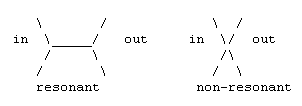Inquiring Minds
|
|
|
Resonances
Dear J. Oldendick, "Why is the cross section for compound nucleus formation not zero between resonances?" In case you are asking this because you've seen a plot of nuclear cross sections, let me point out that the experiment cannot distinguish the multi-particle state, into which the resonance decays, from non-resonant production of that state. Let me sketch a picture of what I mean:
Here the slashes are meant to show incoming and outgoing particles (e.g. original nucleus and neutron coming in, and a smaller nucleus and an alpha particle going out). The key is that the non-resonant mechanism can occur at any energy. Often, the coupling strength of the non-resonant production is so small that it can be neglected. This happens in the interaction of the E-M field with atoms. I don't think you were really asking about non-resonant production, so let's neglect it for the rest of this e-mail. "But doesn't [the shape of the resonance curve] violate fundamental quantum theory? ... How can an atom absorb energy that does not correspond to an allowed excited state? Moreover, most texts treat atoms in an E-M field as a dipole. But doesn't changing the position of the electron cloud relative to the nucleus also change the energy of the atom? How can that be reconciled with quantum mechanics?" These questions, as you suspected, all boil down to the uncertainty principle. Indeed, the uncertainty relations delta x times delta p >= hbar delta E times delta t >= hbar are more fundamental to quantum mechanics than the notion that a nuclear or atomic level has a single energy. (I will address why textbooks say they do below.) Look at the second uncertainty relation, between energy and time. It says that the precision of the energy of a state can only go to zero if you can, and do, look at it infinitely long. With a resonance, or an excited state, you cannot. The compound nucleus breaks up and the excited state drops down to a lower level. So, there should be a relation between the width in the resonance formula, Gamma = sqrt(f), and the halflife of the state. Indeed, halflife = n hbar/Gamma, where n is an uninteresting numerical factor (with ln(2) and so on). So, rather than contradicting fundamental quantum mechanics, the finite width is _required_ by fundamental quantum mechanics, namely the uncertainty principle. In many cases the width is much much smaller than the resolution of any apparatus used to measure the energy splittings. Then it is easier, even if a bit sloppy, to neglect the width and speak of only one allowed energy. That's what textbooks do when they say there's only a handful of allowed energies. In more precise language the difference between the quantum and a classical theory of an atom is this: classical: physical states are arbitrarily close together in energy; any energy is thus, a priori, equally probable. quantum: physical states have isolated (central) energies with well-defined energy spreads (widths); energies far (compared to widths) from central energies are highly improbable (though not impossible). Saying the atom "never" experiences a transition to one of these intermediate energies is just short for so improbable that it won't happen during the course of the measurement (or the lifetime of the measurer, or the lifetime of the universe...). Thank-you for your interest in physics and Fermilab, Andreas Kronfeld Theoretical Physics Department Fermilab
Dear Andreas Kronfeld, How can there be non-resonant absorption of E-M radiation by atoms ? I understand that many times it can be neglected but nevertheless the 1/(E-Eo)^2+f factor shows that some absorption still occurs far away from resonance. How can that be? This is exactly what I cannot reconcile with quantum mechanics. Even if the photon energy is far away from the atomic energy levels, absorption still occurs. Similarly, I cannot understand how a compound nucleus can be formed even when the excitation energy is far away from an energy level in the compound nucleus.
Again thanks,
Dear J. Oldendick,
Andreas Kronfeld
|
| last modified 9/13/1998 physicsquestions@fnal.gov |
FRLsDFx9eyfrPXgV



